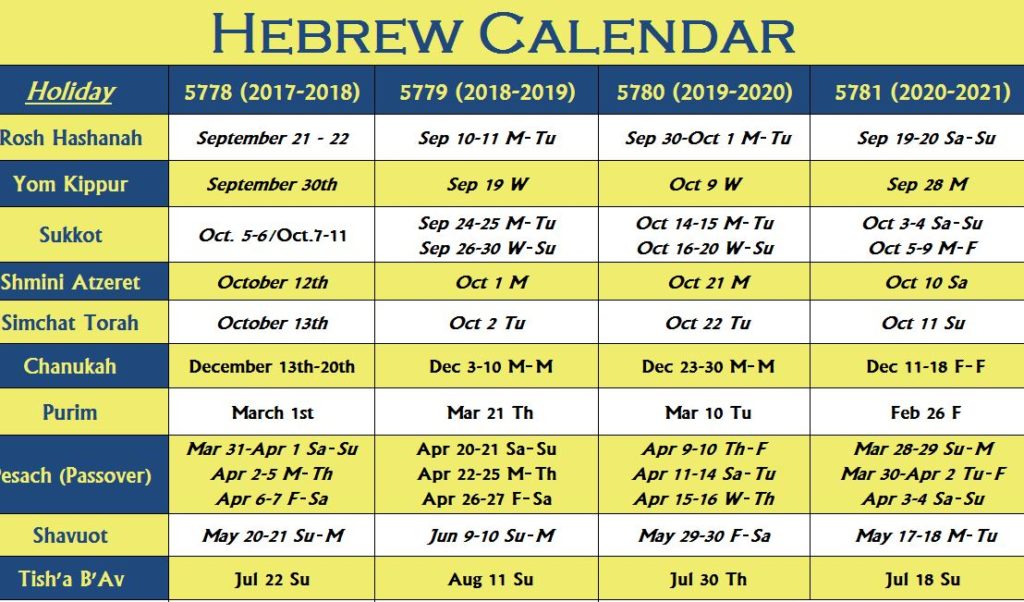First Month Hebrew Calendar - Web a standard jewish year has twelve months; Hallûaḥ hāʿiḇrî), also called the jewish calendar, is a lunisolar calendar used today for jewish religious observance and as an official calendar of israel. Rosh hashanah, the jewish new year, is celebrated during tishrei, followed by yom kippur, the day of atonement. The months in the jewish calendar are based on the moon phases. Features a brief summary of key events in jewish history, laws and customs, shabbat times and more. Though the months follow the lunar cycle, the lunar months must always align themselves with the seasons of the year, which are governed by the sun.
Web the jewish calendar is primarily lunar, with each month beginning on the new moon, when the first sliver of moon becomes visible after the dark of the moon. The hebrew calendar is a lunar calendar meaning that the months are calculated based on the appearance and movement of the moon. Web months in the jewish calendar. What is the first month of the jewish calendar? Though the months follow the lunar cycle, the lunar months must always align themselves with the seasons of the year, which are governed by the sun.
Web use this powerful tool to look up any regular / gregorian calendar date and convert it to its corresponding jewish date, or vice versa. In the torah, nisan, which usually occurs in march and/or april, is called “the first month.” Hallûaḥ hāʿiḇrî), also called the jewish calendar, is a lunisolar calendar used today for jewish religious observance and as an official calendar of israel. Web months in the jewish calendar. Each month begins during the crescent moon when the first sliver of the moon is visible after the dark new moon.
Web for the counting of months, nisan —the month that begins spring—is considered the first. Nissan is the first month on the jewish calendar. Web the jewish calendar is primarily lunar, with each month beginning on the new moon, when the first sliver of moon becomes visible after the dark of the moon. Web tishrei is the first month of the hebrew calendar and usually falls in september or october.
The Full Moon Falls In The Middle Of Each Month, And The Dark Of The Moon Occurs Near The End Of The Month.
In this manner, the jewish year begins with god’s great redemptive act at the time of the exodus from egypt. Web the jewish year is consistent of twelve months. Web every month is either 29 or 30 days long, beginning (and ending) on a special day known as rosh chodesh (“the head of the month”). Web this page shows a chart of the hebrew calendar months with their gregorian calendar equivalents.
In Civil Contexts, A New Year In The Jewish Calendar Begins On Rosh Hashana On Tishrei 1.
The hebrew calendar is a lunar calendar meaning that the months are calculated based on the appearance and movement of the moon. Months in the gregorian calendar. Web according to jewish tradition, the current jewish year is 5784. Rosh hashanah, the jewish new year, is celebrated during tishrei, followed by yom kippur, the day of atonement.
Web For The Counting Of Months, Nisan —The Month That Begins Spring—Is Considered The First.
Sun, moon, and holy scripture. Web in the jewish calendar, each month begins when the moon is just a thin crescent, called rosh chodesh, and a new moon in hebraic tradition. Web the hebrew calendar (hebrew: Hallûaḥ hāʿiḇrî), also called the jewish calendar, is a lunisolar calendar used today for jewish religious observance and as an official calendar of israel.
The Months In The Jewish Calendar Are Based On The Moon Phases.
Nissan is the first month on the jewish calendar. Here are the months in the jewish calendar with their corresponding months in the gregorian calendar: That’s actually a trick question. Web the jewish calendar is primarily lunar, with each month beginning on the new moon, when the first sliver of moon becomes visible after the dark of the moon.
In civil contexts, a new year in the jewish calendar begins on rosh hashana on tishrei 1. Web this page shows a chart of the hebrew calendar months with their gregorian calendar equivalents. Though the months follow the lunar cycle, the lunar months must always align themselves with the seasons of the year, which are governed by the sun. Hallûaḥ hāʿiḇrî), also called the jewish calendar, is a lunisolar calendar used today for jewish religious observance and as an official calendar of israel. Here are the months in the jewish calendar with their corresponding months in the gregorian calendar:





